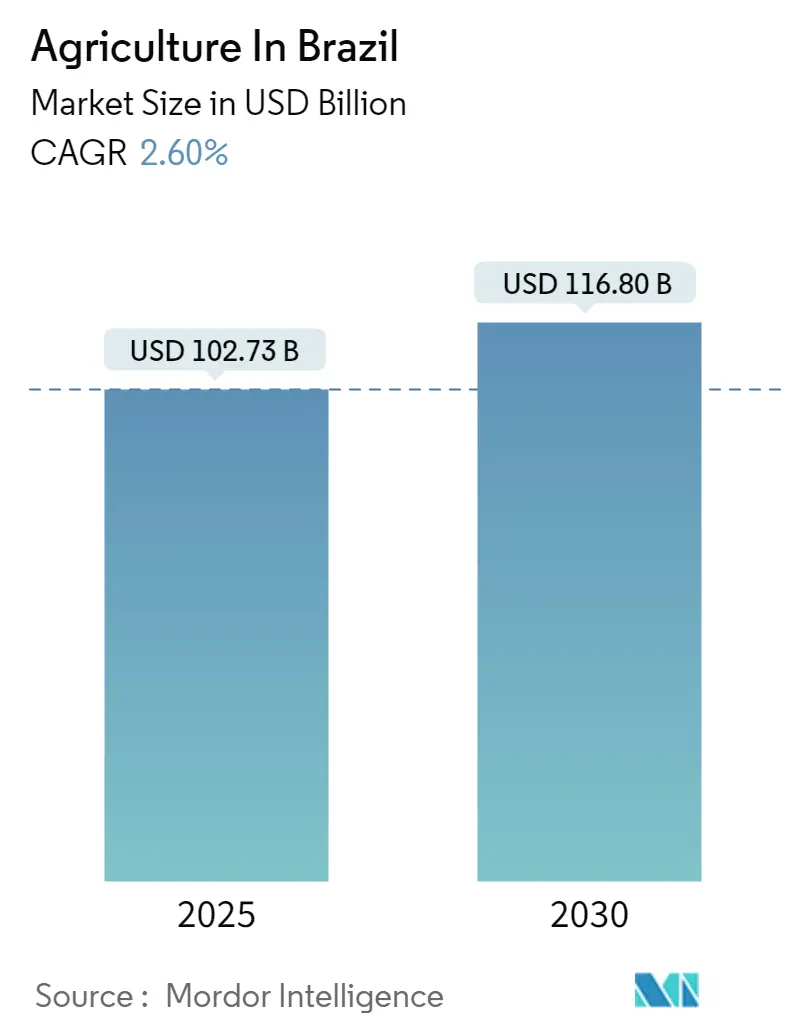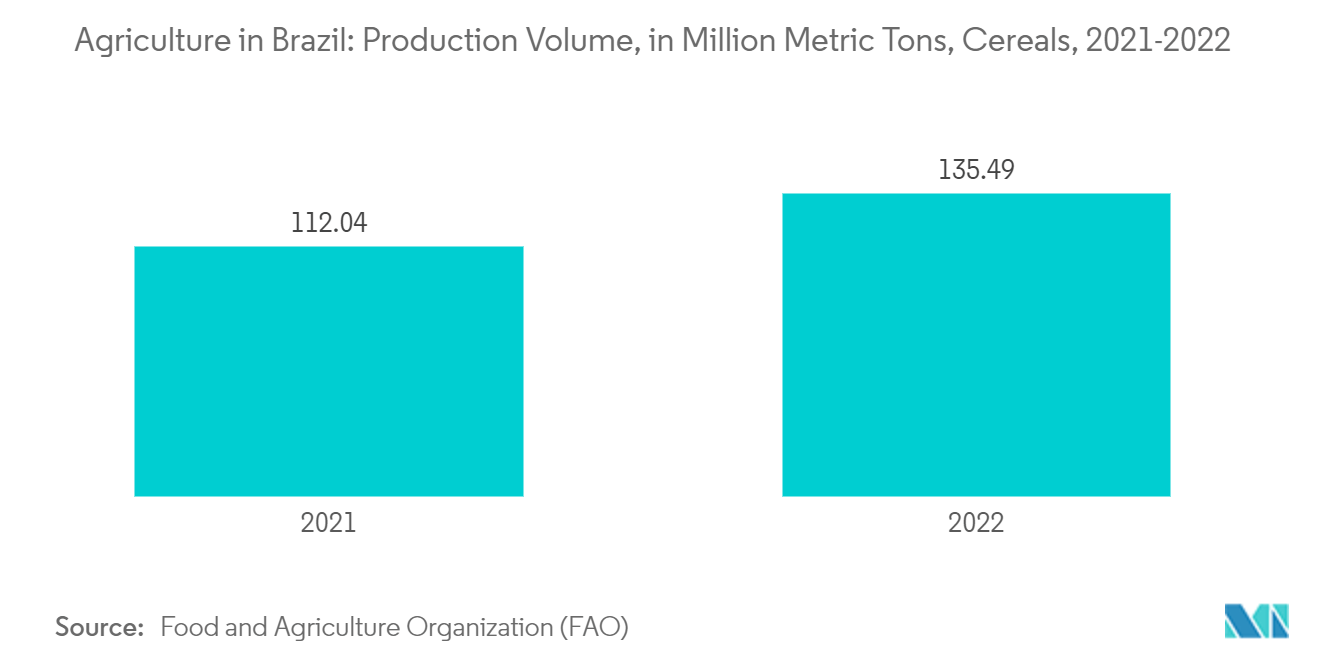
Brazil Agriculture Market Analysis
The Agriculture In Brazil Market size is estimated at USD 102.73 billion in 2025, and is expected to reach USD 116.80 billion by 2030, at a CAGR of 2.6% during the forecast period (2025-2030).
Brazil's vast agricultural capabilities position it as one of the world's top exporters of fruits and vegetables. Globally, it ranks as the third-largest producer of fruits. In 2022, Brazil accounted for 60% of Europe's fruit imports. Leading the charge, Brazil exports grapes, plums, apples, and blueberries. Additionally, it supplies avocados, cherries, walnuts, pears, peaches, and raspberries. In 2022, mangoes and grapes dominated the export scene, constituting 21.1% and 11.0% of the total fruit export value, respectively. Table grapes are emerging as a significant export, with nearly 80% of Brazil's production catering to the export market, emphasizing high-quality and modern grape varieties. In the first half of 2023, Brazil exported 89 metric tons of lime, marking it a leading export. This surge is linked to Brazil's newfound access to the Chilean market for its Tahiti lime. Apples rank among Brazil's top export fruits. Brazil is rejuvenating old orchards with modern varieties like Jazz, Envy, Brookfield, Rosy Glow, and Ambrosia to enhance apple production and boost exports. Yet, challenges loom: a shrinking apple planting area, driven by low profits and fierce international competition, could dampen future exports. In 2022, Brazil's lemon and lime exports hit 156,253.0 metric tons, fetching a value of USD 152,191.0 thousand. Projections estimate exports will climb to 189,214.6 metric tons by the end of the forecast period, achieving a annual growth rate of 3.2%.
Key drivers propelling Brazil's fruit and vegetable market include technological advancements, a growing population, robust economic growth, and a consistent supply of produce. Dominant in Brazilian consumption are oranges, bananas, tomatoes, watermelons, and onions. To bolster exports and meet domestic demand, the government is channeling investments into agriculture, emphasizing the adoption of new technologies. The Government of Brazil (GoB) unveiled a record allocation of BRL 475.5 billion (USD 88.2 billion) for the 2024/25 Crop Plan to strengthen its agricultural industry. This primary public policy focuses on agricultural credit and financing. While the 2024/25 allocation marks a nominal record, representing a 9% increase from the previous year's BRL 435.8 billion (USD 80.9 billion) allocation, representatives from the agricultural industry argue that the funds fall short. They contend that the allocation is inadequate to support farmers grappling with tough market challenges, including declining international commodity prices and soaring production costs. Tomatoes have witnessed the steepest rise in consumer demand. Varieties like Roma or Italian tomatoes, prized for their thick, meaty flesh, are ideal for processing into sauces, pastes, and purees, commanding higher market prices than traditional consumption varieties. National and international dietary guidelines champion the consumption of fresh fruits, underscoring their nutritional benefits. This endorsement has heightened fruit popularity among Brazil's health-conscious consumers. The growing presence of fruits and vegetables in retail and online platforms propels their consumption in Brazil.
Brazil Agriculture Market Trends
Increasing Food Crop Production
Brazil's major crop-producing regions, including Rio Grande do Sul, Santa Catarina, and Parana, have a climate suitable for rainfed crop production. Dominating the agricultural landscape, soybean, maize, sugarcane, and rice comprise 90% of the country's total crop area, solidifying Brazil's status as a leading global producer and exporter of these staples.
As per a USDA report, in 2021, Brazil stood as the world's second-largest producer of biotech crops, with 115 approved events. The USDA's Post projects that in the concluded 2020-2021 crop year, over 56 million hectares were dedicated to genetically engineered (GE) crops. Adoption rates are notably high: 98% for soybeans, 88% for corn, and 80% for cotton. In 2021, data from the Brazilian government revealed a 70% increase in average yields for grains and oilseeds over the past 15 years, with a significant portion of this growth credited to the adoption of biotechnology seeds.
For the 2021-2022 crop season, the Brazilian government unveiled a total fund of BRL 251.2 billion (USD 461 million) to support farmers. This marks a 6.3% increase from the previous Safra Plan. BRL 73.44 billion (USD 142 million) is earmarked for investments, reflecting a substantial 29% rise from the 2020-2021 Safra Plan.
Brazil's diverse climates enable the cultivation of a wide array of fruits, including tropical varieties like mangoes, melons, and grapes. Leveraging advanced agricultural technologies, such as irrigation systems, Brazilian fruit farmers consistently meet and often surpass international quality benchmarks. Data from the Brazilian Association of Fruit Producers and Exporters (ABRAFRUTAS) indicated a 6% increase in export volume and a 26.7% increase in export value in 2023. This growth of 1.085 million tons of fruit has penetrated several discerning international markets. Consequently, Brazil is the third-largest fruit producer globally, trailing only behind dominant exporters China and India, suggesting a burgeoning market demand in the review period.
Growing Trade Opportunities
Brazil has been enhancing its commodity exports to numerous countries. As one of the top producers of agricultural and food products, Brazil leads in oilseed production, particularly soybeans. While Brazil is a dominant player in corn and soybean exports, its fruit exports are also rising. Benefiting from a favorable climate, Brazil has bolstered its supply, enabling it to meet shipment demands from various nations. The country has consistently excelled in commodity exports. The trend holds for fresh fruits, with Brazil setting records for several key exports. In 2023, Brazil's primary fruit exports included lemons, limes, papayas, mangos, watermelons, and melons. According to a USDA report, fresh orange imports reached 32,000 metric tons in 2023, marking a 6.25% rise from the 30,000 metric tons imported the previous year.
These rising export figures underscore a robust demand for Brazilian products. Data from the Secretariat of Foreign Trade (Secex) reveals that exports in August 2023 surged to around 5,910 metric tons, a 454% increase from the previous year. In August, the United Kingdom emerged as the top destination, accounting for 48% of the total exports, followed closely by the Netherlands at 41%.
Data from ITC Trademap indicates that in 2023, Brazil's Apples, pears, and quinces fruit exports, valued at USD 30,783 thousand, primarily reached European nations like the Netherlands, the United Kingdom, Spain, and France, which is higher than the previous year accounted with USD 24,785 thousand. Given this trajectory, the burgeoning export market is poised to invigorate Brazil's domestic agricultural production further, propelling the overall market growth.
Brazil Agriculture Market News
- August 2024: The ApexBrasil program, which incentivizes exports, successfully connected buyers from 63 countries, projecting an impressive USD 86.05 million (BRL 470 million) to boost the agricultural industry.
- April 2024: Brazil targeted self-sufficiency in wheat by harnessing the Cerrado biome, a savanna-like expanse in its central region. The government plans to rejuvenate nearly 4 million hectares of degraded land for wheat cultivation, employing specially adapted seed varieties that can withstand the area's dry climate and soil conditions, outpacing the projected national production of about 9.5 million tons for the marketing year (2024-2025).
Brazil Agriculture Industry Segmentation
Agriculture in Brazil encompasses the production of crops, including cereals, fruits, and vegetables. As a cornerstone of Brazil's economy, the nation stands as a global leader in producing and exporting numerous agricultural commodities. The Brazilian agricultural market is segmented by major crops into food crops/cereals, fruits, and vegetables. The report includes production analysis (volume), consumption analysis (value and volume), export analysis (value and volume), import analysis (value and volume), and price trend analysis. The report offers the market size and forecasts in terms of value (USD) and volume (metric tons) for the above segments.
Brazil Agriculture Market Research FAQs
How big is the Agriculture In Brazil Market?
The Agriculture In Brazil Market size is expected to reach USD 102.73 billion in 2025 and grow at a CAGR of 2.60% to reach USD 116.80 billion by 2030.
What is the current Agriculture In Brazil Market size?
In 2025, the Agriculture In Brazil Market size is expected to reach USD 102.73 billion.
What years does this Agriculture In Brazil Market cover, and what was the market size in 2024?
In 2024, the Agriculture In Brazil Market size was estimated at USD 100.06 billion. The report covers the Agriculture In Brazil Market historical market size for years: 2019, 2020, 2021, 2022, 2023 and 2024. The report also forecasts the Agriculture In Brazil Market size for years: 2025, 2026, 2027, 2028, 2029 and 2030.
Our Best Selling Reports
Brazil Agriculture Industry Report
Statistics for the 2025 Agriculture In Brazil market share, size and revenue growth rate, created by Mordor Intelligence™ Industry Reports. Agriculture In Brazil analysis includes a market forecast outlook for 2025 to 2030 and historical overview. Get a sample of this industry analysis as a free report PDF download.




